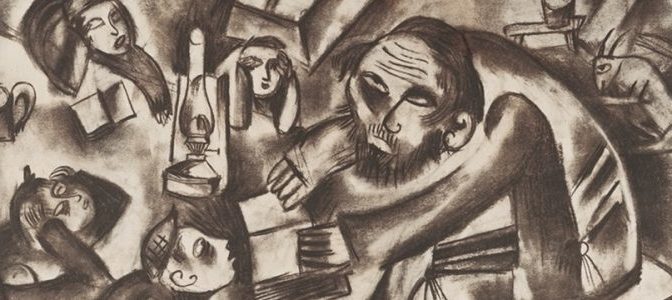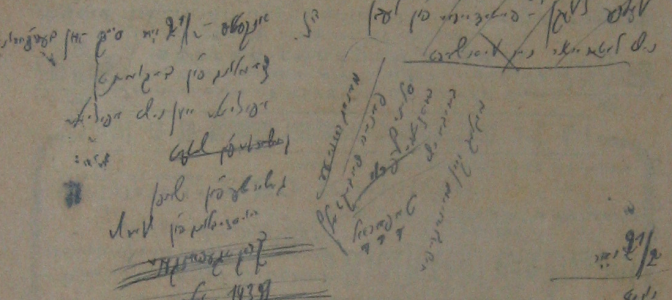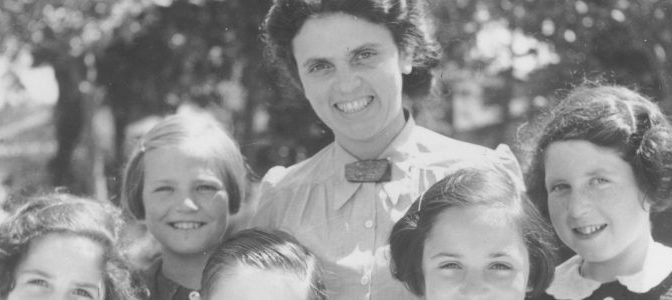
A lecture by Alena Jindrová (Museum of Vysočina Region, Havlíčkův Brod – CZ) in the frame of the Seminar on contemporary Jewish History organized by the Masaryk Institute and Archives of the Czech Academy of Sciences, CEFRES and the Prague Center for Jewish Studies
Where: CEFRES Library, Na Florenci 3, 110 00 Prague 1
When: from 5:30 pm to 7 pm
Language: English
Abstract
During the WWI, refugees came mainly to the central parts of monarchy – Bohemia, Moravia and Austrian lands (Carinthia, Carniola, Lower Austria, Upper Austria). As the war broke out, the first camps were hastily built and transports of refugees were organized by the authorities. But many people fled their houses in chaos and were unable to support themselves. My research project focuses on the refugee camps in the Czech lands and the institutions that were in charge of refugees. So far, no summarizing study deals with the history of refugee camps in the area of the present Czech Republic, such as the large camps in Havlíčkův Brod, Choceň, Kyjov, Mikulov, Pohořelice, Moravská Třebová and Uherské Hradiště. Especially the history of the Moravian camps remains undocumented and we miss even basic a knowledge about when and how they were founded, built, and administrated, and for how many refugees they were intended. I also examine state attempts to control and support refugees and the organization of the aid. Baron Hirsch Fund, Israelitische Alliance in Wien and some regional societies played an important role in providing for the refugees. But in spite of efforts of government and activists, many difficulties remained: research project also focuses on the problematic aspects of the refugee relief, including the history of camps and fates of refugees towards the end of the war.
In cooperation with the “Unlikely refuge?” project.

A lecture by Marianne Windsperger (Vienna Wiesenthal Institute for Holocaust Studies) in the frame of the seminar on Modern Jewish History organized by the Masaryk Institute and Archives of the Czech Academy of Sciences, CEFRES and the Prague Center for Jewish Studies.
Where: CEFRES Library, Na Florenci 3, 110 00 Prague 1
When: from 5:30 pm to 7 pm
Language: English
Abstract
In my PhD dissertation project on “Revisiting and Retelling the Shtetl: Narratives of Searching for Traces in American Jewish Writing” I devote a chapter to references to the yizker bukh tradition in contemporary Jewish writing. The Yiddish term yizker bikher has come to describe a large body of books commemorating destroyed Jewish communities in Eastern Europe. These books have been put together in displaced persons camps immediately after the war or in the hometown societies, the landsmanshaftn. A large number of the yizker bikher include various materials such as maps, photographs, documents as well as lists of names. In narratives that seek to draw transgenerational connections to concrete places, these memorial books are consulted to gain or verify knowledge on specific sites and as a repository of names of the former inhabitants. In this chapter I will carefully trace forms of collecting and writing in contemporary Jewish literature connected to the yizker bukh tradition. Traces of the diasporic medium of the yizker bikher can be found in contemporary American writing, in Argentinian literature as well as in French and German works. Through a comparative approach I will map the afterlife of this genre in world literature and show how these books draw together various writing traditions.

A lecture by Carmen Reichert (Augsburg University) in the frame of the seminar on Modern Jewish History of the Institute of Contemporary History (AV ČR) and CEFRES in partnership with the Masaryk Institute (AV ČR).
Where: CEFRES library, Na Florenci 3, 110 00 Prague 1
When: from 5:30 pm to 7:00 pm
Language: English
Abstract
Narrations on the Choice of Yiddish in Autobiographical Writings after Peretz
It should come as no surprise that literary autobiographies essentially tell us how writers became writers. From Rousseau’s Confessions to Goethe’s Bildungsroman – lire and écrire – an author’s reading lists and their first attempts at writing are crucial topoi to the genre. But the Yiddish writers of the early twentieth century did not grow up with the knowledge that their mother tongue was a literary language. Hebrew and not Yiddish was the language of learning in private schools for Jewish boys. This is why Yiddish writing in the early twentieth-century developed somewhere between the traditional, Hebrew-dominated education system of Cheders and Yeshivas and non-Jewish libraries. According to tradition, written Yiddish texts were primarily intended for women and uneducated men. Therefore, male and female writers developed different writing strategies when writing Yiddish: Whereas women could trace their writings back to early Yiddish autobiographies such as Glikl of Hameln’s “Zikhroynes” (Memories), men preferred to follow Western European traditions. Yiddish autobiographies often link the personal lives of their writers to the history of Yiddish. For example, when Sholem Aleichem compares his life to the market (“yarid”), he simultaneously commits his voice to the “market language” of Yiddish. I. L. Peretz, the “father” of the Yiddish literature, was particularly influential in this context. Not only did he encourage writers to switch to their native language, his autobiography “Mayne zikhroynes” (My Memoirs), which draws inspiration from Romanticism, inspired a great number of autobiographical texts from younger writers.
Carmen Reichert is a postdoctoral researcher at the Augsburg University currently working on a project about literature and language debates in context of the Czernowitz language conference. For more, please see here.

A lecture by Marcos Silber (University in Haifa) in the frame of the seminar on Modern Jewish History of the Institute of Contemporary History (AV ČR) and CEFRES in partnership with the Masaryk Institute (AV ČR).
Where: CEFRES library, Na Florenci 3, 110 00 Prague 1
When: from 5:30 pm to 7:00 pm
Language: English
Abstract
March 1968 was a short but important period in recent Polish history. That year, it seemed, almost the whole world was experiencing a cultural revolution provoked by the youth. Unlike most of the historical research on Poland in March 1968, which has tended to focus on political power struggles and rising antisemitism, this paper explores connections between post-war Polish-Jewish youth subculture, a group sidelined because of its ethnicity and age, and the anti-Jewish campaign of March 1968 which led to the emigration of thousands of Polish Jews.

A lecture by Joanna Nalewajko-Kulikov (Tadeusz Manteuffel Institute of History, Polish Academy of Sciences) in the frame of the seminar on Modern Jewish History of the Institute of Contemporary History (AV ČR) and CEFRES in partnership with the Masaryk Institute (AV ČR).
Where: CEFRES library, Na Florenci 3, 110 00 Prague 1
When: from 5:30 pm to 7:00 pm
Language: English
Abstract
In September 1939 a Polish-Jewish historian, teacher and social activist Emanuel Ringelblum (1900–1944) began taking notes on various aspects of wartime reality, an activity he continued until January 1943. It was the beginning of a wider documenting project, later known under the codename of “Oneg Shabbat” or the Underground Archive of the Warsaw Ghetto. They were unearthed after the war and are now held in the Jewish Historical Institute Archive in Warsaw. A small part is located in Hersh Wasser Collection, YIVO Institute for Jewish Research in New York.
Ringelblum’s notes were published in the original language (Yiddish) in Warsaw in 1952 (Notitsn fun varshever geto), 1961–1963 (Ksovim fun geto) and in Tel Aviv in 1985 (reprint of the 1961–1963 edition including notes from the Hersh Wasser Collection). The Polish translation was prepared by Adam Rutkowski in the late 1950s, but was withdrawn from the printing house following the antisemitic campaign of 1968. It finally came out in 1983, edited by Artur Eisenbach, under the title Kronika getta warszawskiego.
In my lecture I would like to share some of my experiences from preparing a new, critical and completed edition (Pisma Emanuela Ringelbluma z getta, ed. Joanna Nalewajko-Kulikov, transl. Agata Kondrat [et al.], Warszawa 2018, series „Archiwum Ringelbluma. Konspiracyjne Archiwum Getta Warszawy”, vol. 29). I will show the differences between the new edition and the previous ones and will discuss problems that arise upon editing a source which reached us as an unfinished draft which was never intended to be published in this form.
Joanna Nalewajko-Kulikov is Associate Professor at the Tadeusz Manteuffel Institute of History of the Polish Academy of Sciences. Her research focuses on the history of East European Jewry in the 19th and 20th century, history of Yiddish culture (especially Yiddish daily press) and Polish-Jewish relations. Her books include, among others, Obywatel Jidyszlandu. Rzecz o zydowskich komunistach w Polsce (2009; English translation forthcoming 2019) and Mowic we wlasnym imieniu. Prasa jidyszowa a tworzenie zydowskiej tozsamosci narodowej (2016). For the publishing series “Archiwum Ringelbluma” she edited memoirs of Tsvi Prylucki (2015) and Emanuel Ringelblum’s notes from the Warsaw ghetto (2018). She is currently working on a book-length project devoted to Yiddish press in interwar Poland.

A lecture by Laura Hobson Faure (Université Sorbonne Nouvelle – Paris 3) in the frame of the seminar on Modern Jewish History of the Institute of Contemporary History (AV ČR) and CEFRES in partnership with the Masaryk Institute (AV ČR).
Where: CEFRES library, Na Florenci 3, 110 00 Prague 1
When: from 5:30 pm to 7:00 pm
Language: English
Abstract
Since the 1990s, historians have sought to incorporate Jewish children’s experiences into the historiography on the Holocaust (Dwork, 1991, Stargardt, 2006), seeking out child-produced sources to write child-centered histories. Childhood as a sub-field of Holocaust studies has continued to develop, and now includes works on Jewish children’s experiences in Occupied Europe, as well as in the countries to which they fled (Michlic 2017, Gigliotti and Tempian, 2016, Cohen 2018, Ouzan 2018). However, historians have often constructed their work within local or national frameworks, remaining staunchly attached to a narrow periodization, focusing either on the war years or the postwar period. My current research, on a small group of about 300 children who fled from Central Europe to France in 1938-39, and from France to the United States in 1941-42, proposes a new reading of this history by considering children’s lives in transnational perspective, over a period of time that includes both the Holocaust and its long aftermath. By following the process through which children became refugees, I will shed light on little known child-evacuation schemes, but also question how these children, as adults, shaped the rise of contemporary Holocaust memory, as Holocaust survivors. This project thus proposes a microhistory of children’s networks, with the hope of raising larger questions of how individuals and families responded to persecution collectively, how social work practices and organizations shaped children’s lives, and how former child victims shaped the rise of Holocaust memory in Western Democracies.






